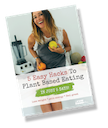Dealing with Candida overgrowth can be challenging, especially when the foods we consume daily might be exacerbating the problem.
Candida, a type of yeast, naturally lives in small amounts in our bodies.
However, when it grows out of control, it can cause a host of health issues, including fatigue, digestive problems, and infections, and can become systemic.
The food we eat plays a significant role in either feeding or starving Candida. There are many other foods to avoid that are more commonly known such as sugar and fruit.
However there are hidden food ingredients you should also avoid if you want to truly heal from Candida.
Here are the four hidden food ingredients that feed Candida:
-
Maltodextrin
Maltodextrin is a common food additive used as a filler and to extend the shelf life of packaged foods. You’ll find it in everything from sauces to snack bars. Despite its widespread use, maltodextrin is a high-glycemic ingredient, meaning it spikes your blood sugar levels even more than table sugar. High blood sugar levels create an environment in which Candida thrives.
Why It Feeds Candida:
Maltodextrin’s high glycemic index means it is quickly broken down into glucose in the digestive system, providing a rapid source of sugar that Candida yeast loves. Consuming foods with maltodextrin can therefore lead to an overgrowth of Candida.
Tip:
Always check the back of any packaged food before buying. Look out for maltodextrin listed among the ingredients. Opt for whole, unprocessed foods as much as possible.
-
MSG, Yeast Extract, and Malt Extract
These flavor enhancers are ubiquitous in processed foods. Manufacturers use MSG (monosodium glutamate), yeast extract, and malt extract to enhance the flavor of food. These ingredients are often chosen as cheaper alternatives to real food ingredients.
Why They Feed Candida:
MSG and its counterparts can disrupt the balance of your gut flora, promoting the growth of Candida. They can create an imbalance that suppresses beneficial bacteria and allows yeast to proliferate.
Alternative:
If you want to enhance the umami flavor of your meals, try using Tamari. Tamari is a yeast-free soy sauce alternative that provides a rich flavor without feeding Candida.
-
‘Natural Flavors’ and Artificial Sweeteners
The term ‘natural flavors’ might sound harmless, but it’s a catch-all phrase that can include up to 50 different lab-produced chemicals.
Although these flavors may be derived from natural sources initially, the end product can be far from natural. Artificial sweeteners are another culprit. While they are often marketed as healthy alternatives to sugar, they can actually do more harm than good.
Why They Feed Candida:
The lab-produced chemicals in ‘natural flavors’ and artificial sweeteners can disrupt your gut bacteria and raise blood sugar levels over time, both of which can feed Candida.
These sweeteners can also create an environment in your gut that promotes the growth of yeast.
Better Choices:
Switch to natural sweeteners like Stevia or Xylitol.
These alternatives do not raise blood sugar levels and are less likely to feed Candida.
-
Chlorine in Tap Water
While not a food ingredient, chlorine in tap water is something you ingest daily. Chlorine is used to disinfect drinking water, but it can also act like an antibiotic inside your body.
Why It Feeds Candida:
Chlorine kills off good bacteria in your gut, disrupting the delicate balance of your microbiome.
When the beneficial bacteria are reduced, Candida has the opportunity to flourish.
Solution:
Invest in a good quality water filter that removes chlorine. By doing so, you can help maintain a healthy balance of gut bacteria and prevent Candida overgrowth.
Conclusion:
Avoiding these hidden ingredients can make a significant difference in your battle against Candida.
By focusing on eliminating these problematic ingredients from your diet, you can create an environment in your body that is less hospitable to Candida and more supportive of overall gut health.
Remember, the key to healing is not just about what you avoid, but also what you choose to include in your diet.
Opt for nutrient-dense, whole foods that nourish your body and support a healthy microbiome.
Check out my Every Day Healthy Course HERE or my 4 Week Gut Makeover Program HERE if you want clean eating recipes that include plenty of gut loving ingredients.
Much raw <3
Amanda



